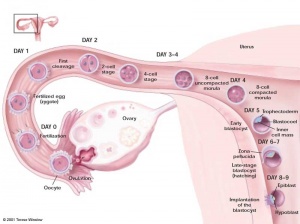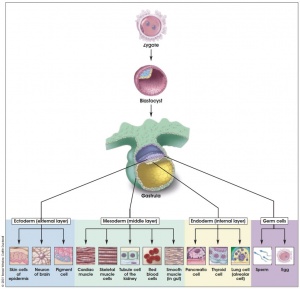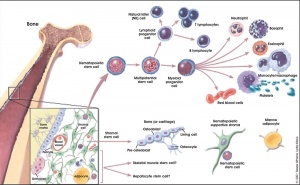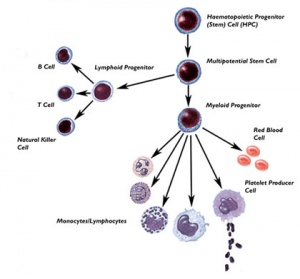2009 Lab 10: Difference between revisions
No edit summary |
|||
| Line 2: | Line 2: | ||
[[File:CSt3.jpg|left]] | [[File:CSt3.jpg|left]] | ||
== Introduction == | == Introduction == | ||
This laboratory will be presented by a guest researcher and will look at the topic of stem cells | This laboratory will be presented by a guest researcher and will look at the topic of stem cells, their therapeutic use, practical hurdles and ethical issues. | ||
This topic is also covered in [http://php.med.unsw.edu.au/cellbiology/index.php?title=2009_Lecture_21 ANAT3231 Cell Biology - Stem Cells] in relation to stem cell research and applications. | This topic is also covered in [http://php.med.unsw.edu.au/cellbiology/index.php?title=2009_Lecture_21 ANAT3231 Cell Biology - Stem Cells] in relation to stem cell research and applications. | ||
==Therapeutic Use of Stem Cells - Practical Hurdles & Ethical Issues== | |||
The laboratory will also allow time for work on the group online project. | The laboratory will also allow time for work on the group online project. | ||
Revision as of 10:08, 18 September 2009
Stem Cells
Introduction
This laboratory will be presented by a guest researcher and will look at the topic of stem cells, their therapeutic use, practical hurdles and ethical issues.
This topic is also covered in ANAT3231 Cell Biology - Stem Cells in relation to stem cell research and applications.
Therapeutic Use of Stem Cells - Practical Hurdles & Ethical Issues
The laboratory will also allow time for work on the group online project.
Timeline of Human Embryonic Stem Cell Research
- 1878 First reported attempts to fertilize mammalian eggs outside the body
- 1959 First report of animals (rabbits) produced through IVF in the United States
- 1960's Studies of teratocarcinomas in the testes of several inbred strains of mice indicates they originated from embryonic germ cells. The work establishes embryonal carcinoma (EC) cells as a kind of stem cell
- 1968 Edwards and Bavister fertilize the first human egg in vitro
- 1970's EC cells injected into mouse blastocysts produce chimeric mice. Cultured SC cells are explored as models of embryonic development, although their complement of chromosomes is abnormal
- 1978 Louise Brown, the first IVF baby, is born in England
- 1980 Australia's first IVF baby, Candace Reed, is born in Melbourne
- 1981 Evans and Kaufman, and Martin derive mouse embryonic stem (ES) cells from the inner cell mass of blastocysts. They establish culture conditions for growing pluripotent mouse ES cells in vitro. The ES cells yield cell lines with normal, diploid karyotyes and generate derivatives of all three primary germ layers as well as primordial germ cells. Injecting the ES cells into mice induces the formation of teratomas. The first IVF baby, Elizabeth Carr, is born in the United States.
- 1984–88 Andrews et al., develop pluripotent, genetically identical (clonal) cells called embryonal carcinoma (EC) cells from Tera-2, a cell line of human testicular teratocarcinoma. Cloned human teratoma cells exposed to retinoic acid differentiate into neuron-like cells and other cell types
- 1989 Pera et al., derive a clonal line of human embryonal carcinoma cells, which yields tissues from all three primary germ layers. The cells are aneuploid (fewer or greater than the normal number of chromosomes in the cell) and their potential to differentiate spontaneously in vitro is typically limited. The behavior of human EC cell clones differs from that of mouse ES or EC cells
- 1994 Human blastocysts created for reproductive purposes using IVF and donated by patients for research, are generated from the 2-pronuclear stage. The inner cell mass of the blastocyst is maintained in culture and generates aggregates with trophoblast-like cells at the periphery and ES-like cells in the center. The cells retain a complete set of chromosomes (normal karyotype); most cultures retain a stem cell-like morphology, although some inner cell mass clumps differentiate into fibroblasts. The cultures are maintained for two passages
- 1995–96 Non-human primate ES cells are derived and maintained in vitro, first from the inner cell mass of rhesus monkeys, and then from marmosets. The primate ES cells are diploid and have normal karyotypes. They are pluripotent and differentiate into cells types derived from all three primary germ layers. The primate ES cells resemble human EC cells and indicate that it should be possible to derive and maintain human ES cells in vitro.
- 1998 Thomson et al., derive human ES cells from the inner cell mass of normal human blastocysts donated by couples undergoing treatment for infertility. The cells are cultured through many passages, retain their normal karyotypes, maintain high levels of telomerase activity, and express a panel of markers typical of human EC cells non-human primate ES cells. Several (non-clonal) cell lines are established that form teratomas when injected into immune-deficient mice. The teratomas include cell types derived from all three primary germ layers, demonstrating the pluripotency of human ES cells. Gearhart and colleagues derive human embryonic germ (EG) cells from the gonadal ridge and mesenchyma of 5- to 9-week fetal tissue that resulted from elective abortions. They grow EG cells in vitro for approximately 20 passages, and the cells maintain normal karyotypes. The cells spontaneously form aggregates that differentiate spontaneously, and ultimately contain derivatives of all three primary germ layers. Other indications of their pluripotency include the expression of a panel of markers typical of mouse ES and EG cells. The EG cells do not form teratomas when injected into immune-deficient mice
- 2000 Scientists in Singapore and Australia led by Pera, Trounson, and Bongso derive human ES cells from the inner cell mass of blastocysts donated by couples undergoing treatment for infertility. The ES cells proliferate for extended periods in vitro, maintain normal karyotypes, differentiate spontaneously into somatic cell lineages derived from all three primary germ layers, and form teratomas when injected into immune-deficient mice.
- 2001 As human ES cell lines are shared and new lines are derived, more research groups report methods to direct the differentiation of the cells in vitro. Many of the methods are aimed at generating human tissues for transplantation purposes, including pancreatic islet cells, neurons that release dopamine, and cardiac muscle cells.
References
Textbooks
- Molecular Biology of the Cell Alberts, Bruce; Johnson, Alexander; Lewis, Julian; Raff, Martin; Roberts, Keith; Walter, Peter New York and London: Garland Science; c2002 Chapter 19 Cellular Mechanisms of Development p1037-1039 | Figure 22-4. The definition of a stem cell | Figure 22-19. Renewal of the gut lining | Figure 22-5. Two ways for a stem cell to produce daughters with different fates
- Molecular Cell Biology Lodish, Harvey; Berk, Arnold; Zipursky, S. Lawrence; Matsudaira, Paul; Baltimore, David; Darnell, James E. New York: W. H. Freeman & Co.; c1999 Chapter 23. Cell Interactions in Development Figure 24-8. Formation of differentiated blood cells from hematopoietic stem cells in the bone marrow
- The Cell- A Molecular Approach Cooper, Geoffrey M. Sunderland (MA): Sinauer Associates, Inc.; c2000 IV. Cell Regulation Chapter 14. Cell Proliferation in Development and Differentiation Stem Cells
Search
- Bookshelf stem cell |
Links
- UNSW Embryology Stem Cells | Stem Cells - Ethics | Stem Cells - Cord Blood | Stem Cells - Adult
- Australian Stem Cell Centre Australian Stem Cell Centre | Public Education | Fact Sheets | Australasian Society for Stem Cell Research
- NIH Stem Cell Information Home Page | Stem Cell Bank (NSCB) | Stem Cells: Scientific Progress and Future Research Directions 2001 | Regenerative Medicine 2006
- International Consortium of Stem Cell Networks International Consortium of Stem Cell Networks | Stem Cell Legislation - World Map | FAQs
- STEM CELLS Journal Stem Cells Portal
Glossary Links
- Glossary: A | B | C | D | E | F | G | H | I | J | K | L | M | N | O | P | Q | R | S | T | U | V | W | X | Y | Z | Numbers | Symbols | Term Link
Course Content 2009
Embryology Introduction | Cell Division/Fertilization | Cell Division/Fertilization | Week 1&2 Development | Week 3 Development | Lab 2 | Mesoderm Development | Ectoderm, Early Neural, Neural Crest | Lab 3 | Early Vascular Development | Placenta | Lab 4 | Endoderm, Early Gastrointestinal | Respiratory Development | Lab 5 | Head Development | Neural Crest Development | Lab 6 | Musculoskeletal Development | Limb Development | Lab 7 | Kidney | Genital | Lab 8 | Sensory - Ear | Integumentary | Lab 9 | Sensory - Eye | Endocrine | Lab 10 | Late Vascular Development | Fetal | Lab 11 | Birth, Postnatal | Revision | Lab 12 | Lecture Audio | Course Timetable
Cite this page: Hill, M.A. (2024, May 2) Embryology 2009 Lab 10. Retrieved from https://embryology.med.unsw.edu.au/embryology/index.php/2009_Lab_10
- © Dr Mark Hill 2024, UNSW Embryology ISBN: 978 0 7334 2609 4 - UNSW CRICOS Provider Code No. 00098G




